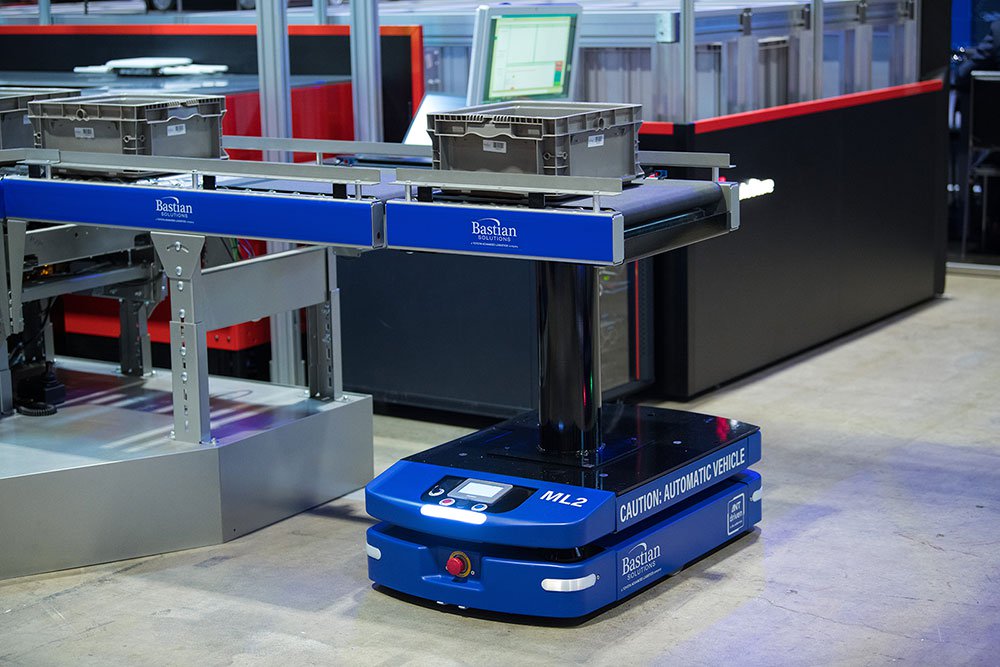
Leveraging Autonomous Vehicles: Why & How?
Bailey Ludlam & Katie Smith | 26 July 2023
One size does not fit all. As a material handling systems integrator, we know that all too well. That phrase is especially true for trending technologies like autonomous vehicles or AVs. Encompassing both AGVs (automated guided vehicles) and AMRs (autonomous mobile robots), AVs provide a quick method to gain efficiencies in operation processes without installing infrastructure.
To determine optimal use cases to leverage AVs for the best return on investment, you’ll first want to take into consideration points like load characteristics, required accuracy and system compatibility. These details can help narrow the scope on the type of AV required and help integrators determine what to teach the vehicles in order to support your specific operations. This helps to maximize the benefits you’ll gain from single or multiple units.
AGVs vs. AMRs: what are they?
AGVs and AMRs are both used to move materials within an application using computer-controlled navigation systems. This advanced material handling solution comes in a variety of sizes and capacities, and, for the most part, can be engineered to handle any specific product type. This means anything from small order fulfillment ecommerce goods to heavy and large payloads.
AGVs rely on pre-programmed software for instructions and travel on a fixed path - magnetic tape, RFID tags, etc. AMRs utilize advanced perception-based navigation and aren't limited to one specific route. AGVs are ideal for very standardized tasks that require a high degree of precision. AMRs are best employed in environments that involve a considerable amount of human interaction and collaboration.
According to Frost & Sullivan, the AGV segment is forecasted to hit $4.6 billion, and the AMR segment is forecasted to hit $6.8 billion by 2025. Why are AGVs and AMRs becoming increasingly popular solutions?
Automated guided vehicle and autonomous mobile robot systems are generally:
- Easy to integrate and user configurable to adapt to market changes.
- Reduce dependency on labor costs with easy expansion and ability to manage task changes.
- Increase speed and accuracy by improving traffic flow, reducing variability and improving traceability.
- Improve product and employee safety by reducing repetitive tasks and AV use of safety systems.
- Offer space and infrastructure savings through little to no facility modifications required.
What are some common AGV and AMR applications?
TRANSPORTING GOODS – Autonomous vehicles are capable of complex logistics and distribution functions, including transporting goods in assembly operations or in warehouses for sortation, order picking, and goods to person order fulfillment..JPG)
PALLET HANDLING – Optimize the tedious, labor intensive task of transporting and storing pallets with safe, reliable autonomous forklifts and dual-mode pallet trucks.
CART TRANSPORT AND DELIVERY – Tunnel AGVs, AGCs (automated guided carts) and tuggers are designed to transport carts carrying a variety of payloads around manufacturing and distribution facilities.
CUSTOMIZED SOLUTIONS – No one size fits all. AGVs can be outfitted with customizable frames, decks, and conveyor to fit a variety of distribution and manufacturing applications.
What does the future look like?

Bastian had the opportunity to host a webinar with MHI, check out "The Future of AGVs." Bastian Solutions' General Manager of Autonomous Vehicles Michael Marcum discusses the future of AGVs in the material handling industry and how he's seen AGVs support customer objectives by safely and consistently transporting products and materials in manufacturing and distribution operations. Listen here.
Bailey is the Brand Manager at Bastian Solutions, based out of Indianapolis, Indiana. She is PCM certified through American Marketing Association, has a bachelor’s degree from Washington College and 10 years experience working in marketing and journalism. Outside of work, Bailey enjoys spending time with her husband and two children and can usually be found hiking, running or creating with LEGO bricks.
Katie is a Bastian Solutions product marketing specialist, based out of Indianapolis, Indiana. She received her Bachelor of Science in Public Relations from Ball State University. Katie works directly with the manufacturing and service divisions to develop effective communication and collateral for Bastian Solutions’ products and services.
Comments
No comments have been posted to this Blog Post
Leave a Reply
Your email address will not be published.
Comment
Thank you for your comment.